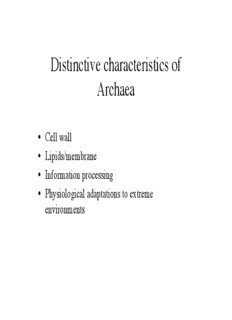
Distinctive characteristics of Archaea - Science Center PDF
Preview Distinctive characteristics of Archaea - Science Center
Distinctive characteristics of Archaea • Cell wall • Lipids/membrane • Information processing • Physiological adaptations to extreme environments Pseudomurein Fig. 20.2 Substitutes for N-Acetylmuramic acid (NAM) of peptidoglycan Gram+ vs. Gram- Archaea Gram+ Cell wall of pseudomurein or other complex carbohydrate Gram- No outer membrane No cell wall Thick protein/glycoprotein coat Fig. 20.1 Archaeal Lipids • Fatty acid attached by ether not ester links • Varying lengths of carbon side chains- 20 or 40 carbon Fig. 20.3 Flexible Rigid- gives membrane stability to thermophiles Fig. 20.5 Archaea Similarities to prokaryotes Similarities to eukaryotes • Size • Few plasmids • Shape • RNA polymerase/promoters • Lack nucleus • Translation machinery: • Single chromosome ribosome and tRNA • Genes in operons • No introns Sequencing of Methanococcus jannaschii in 1992 56% of genes not similar to bacteria or eukaryotes! Major groups of Archaea • Methanogenic archaea • Archaeal sulfate reducers • Extremely halophilic archaea • Cell wall-less archaea • Extremely thermophilic S0-metabolizers Methanogens • Largest group of Archaea • Form methane (CH ) from CO or other 4 2 compounds (e.g. formate, methanol, acetate) • Strict anaerobes • Found in a variety of anaerobic environments rich in organic matter • Causes cows to belch! • Methane: energy source vs. greenhouse gases Fig. 20.12 Fig. 20.10
Description: